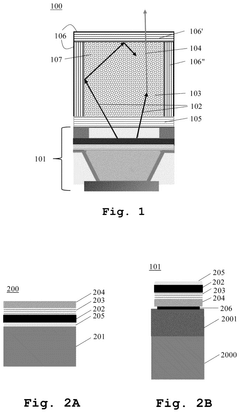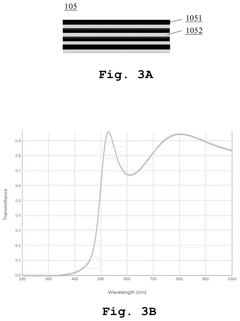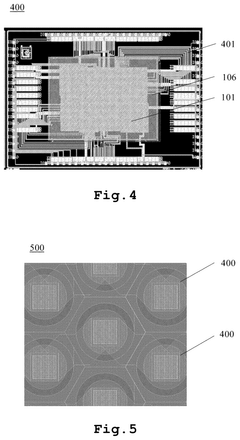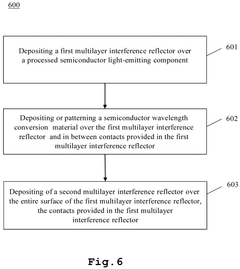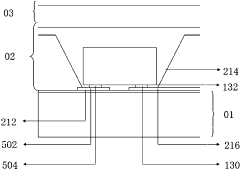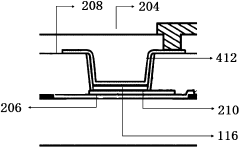ULED Platforms: Bridging the Gap to Advanced‑Tech Integration
JUN 20, 20259 MIN READ
Generate Your Research Report Instantly with AI Agent
Patsnap Eureka helps you evaluate technical feasibility & market potential.
ULED Tech Evolution
ULED (Ultra-Low Energy Devices) technology has undergone significant evolution since its inception, marking a transformative journey in the realm of advanced-tech integration. The progression of ULED platforms can be traced through several key developmental stages, each characterized by breakthrough innovations and enhanced capabilities.
In the early phases, ULED technology primarily focused on reducing power consumption in basic electronic components. This initial stage saw the introduction of low-power microcontrollers and simple sensors, laying the groundwork for more sophisticated energy-efficient devices. As research advanced, the second generation of ULED platforms emerged, incorporating more complex system-on-chip (SoC) designs that integrated multiple functions while maintaining ultra-low energy profiles.
The third wave of ULED evolution brought about a paradigm shift with the integration of artificial intelligence and machine learning capabilities. This milestone enabled devices to not only operate with minimal energy but also to adapt and optimize their performance based on usage patterns and environmental conditions. The incorporation of edge computing further enhanced the efficiency and responsiveness of ULED platforms, allowing for local data processing and reducing the need for constant cloud connectivity.
Recent advancements have pushed ULED technology into the realm of IoT and smart environments. The latest generation of ULED platforms features seamless connectivity options, including low-power wide-area networks (LPWAN) and energy-harvesting technologies. These innovations have extended the operational lifespan of devices from months to years on a single charge or even enabled perpetual operation through ambient energy harvesting.
The evolution of ULED platforms has also seen significant improvements in manufacturing processes and materials science. The development of advanced semiconductor materials and fabrication techniques has allowed for the creation of increasingly miniaturized and efficient components. This has not only reduced the overall energy consumption but also expanded the potential applications of ULED technology across various industries.
Looking ahead, the trajectory of ULED evolution points towards even greater integration with emerging technologies. The convergence of ULED platforms with quantum computing, neuromorphic engineering, and molecular electronics promises to unlock new frontiers in energy-efficient computing and sensing. As these technologies mature, we can anticipate ULED platforms that operate at the atomic level, potentially revolutionizing fields such as healthcare, environmental monitoring, and space exploration.
The continuous evolution of ULED technology underscores its critical role in bridging the gap to advanced-tech integration. By consistently pushing the boundaries of energy efficiency and functionality, ULED platforms are paving the way for a future where ubiquitous computing becomes a reality without compromising sustainability or performance.
In the early phases, ULED technology primarily focused on reducing power consumption in basic electronic components. This initial stage saw the introduction of low-power microcontrollers and simple sensors, laying the groundwork for more sophisticated energy-efficient devices. As research advanced, the second generation of ULED platforms emerged, incorporating more complex system-on-chip (SoC) designs that integrated multiple functions while maintaining ultra-low energy profiles.
The third wave of ULED evolution brought about a paradigm shift with the integration of artificial intelligence and machine learning capabilities. This milestone enabled devices to not only operate with minimal energy but also to adapt and optimize their performance based on usage patterns and environmental conditions. The incorporation of edge computing further enhanced the efficiency and responsiveness of ULED platforms, allowing for local data processing and reducing the need for constant cloud connectivity.
Recent advancements have pushed ULED technology into the realm of IoT and smart environments. The latest generation of ULED platforms features seamless connectivity options, including low-power wide-area networks (LPWAN) and energy-harvesting technologies. These innovations have extended the operational lifespan of devices from months to years on a single charge or even enabled perpetual operation through ambient energy harvesting.
The evolution of ULED platforms has also seen significant improvements in manufacturing processes and materials science. The development of advanced semiconductor materials and fabrication techniques has allowed for the creation of increasingly miniaturized and efficient components. This has not only reduced the overall energy consumption but also expanded the potential applications of ULED technology across various industries.
Looking ahead, the trajectory of ULED evolution points towards even greater integration with emerging technologies. The convergence of ULED platforms with quantum computing, neuromorphic engineering, and molecular electronics promises to unlock new frontiers in energy-efficient computing and sensing. As these technologies mature, we can anticipate ULED platforms that operate at the atomic level, potentially revolutionizing fields such as healthcare, environmental monitoring, and space exploration.
The continuous evolution of ULED technology underscores its critical role in bridging the gap to advanced-tech integration. By consistently pushing the boundaries of energy efficiency and functionality, ULED platforms are paving the way for a future where ubiquitous computing becomes a reality without compromising sustainability or performance.
Market Demand Analysis
The market demand for ULED (Ultra-Light Emitting Diode) platforms has been steadily increasing as industries seek more advanced and efficient display technologies. This demand is driven by the growing need for high-performance, energy-efficient displays across various sectors, including consumer electronics, automotive, and industrial applications.
In the consumer electronics market, ULED platforms are gaining traction due to their superior image quality, brightness, and energy efficiency compared to traditional LED and OLED technologies. Smartphones, tablets, and televisions are the primary drivers of this demand, with consumers increasingly expecting higher resolution, better color accuracy, and improved contrast ratios in their devices.
The automotive industry is another significant contributor to the market demand for ULED platforms. As vehicles become more technologically advanced, there is a growing need for sophisticated display systems for infotainment, driver assistance, and instrument clusters. ULED technology offers the potential for brighter, more responsive displays that can perform well in various lighting conditions, making it an attractive option for automotive manufacturers.
Industrial applications, including digital signage, control panels, and medical imaging equipment, are also fueling the demand for ULED platforms. These sectors require displays that can deliver high brightness, long lifespan, and consistent performance in challenging environments. ULED technology's ability to meet these requirements while offering improved energy efficiency makes it an appealing choice for industrial users.
The market for ULED platforms is expected to experience substantial growth in the coming years. This growth is attributed to the technology's potential to bridge the gap between current display technologies and more advanced solutions. As manufacturers continue to invest in research and development, the capabilities of ULED platforms are likely to expand, further driving market demand.
Geographically, Asia-Pacific is anticipated to be the largest market for ULED platforms, with countries like China, South Korea, and Japan leading in both production and consumption. North America and Europe are also expected to see significant growth in demand, particularly in high-end consumer electronics and automotive applications.
Despite the positive outlook, there are challenges that may impact market demand. These include the high initial costs associated with ULED technology, competition from other emerging display technologies, and the need for standardization across the industry. However, as the technology matures and economies of scale are achieved, these barriers are expected to diminish, potentially leading to wider adoption and increased market demand for ULED platforms.
In the consumer electronics market, ULED platforms are gaining traction due to their superior image quality, brightness, and energy efficiency compared to traditional LED and OLED technologies. Smartphones, tablets, and televisions are the primary drivers of this demand, with consumers increasingly expecting higher resolution, better color accuracy, and improved contrast ratios in their devices.
The automotive industry is another significant contributor to the market demand for ULED platforms. As vehicles become more technologically advanced, there is a growing need for sophisticated display systems for infotainment, driver assistance, and instrument clusters. ULED technology offers the potential for brighter, more responsive displays that can perform well in various lighting conditions, making it an attractive option for automotive manufacturers.
Industrial applications, including digital signage, control panels, and medical imaging equipment, are also fueling the demand for ULED platforms. These sectors require displays that can deliver high brightness, long lifespan, and consistent performance in challenging environments. ULED technology's ability to meet these requirements while offering improved energy efficiency makes it an appealing choice for industrial users.
The market for ULED platforms is expected to experience substantial growth in the coming years. This growth is attributed to the technology's potential to bridge the gap between current display technologies and more advanced solutions. As manufacturers continue to invest in research and development, the capabilities of ULED platforms are likely to expand, further driving market demand.
Geographically, Asia-Pacific is anticipated to be the largest market for ULED platforms, with countries like China, South Korea, and Japan leading in both production and consumption. North America and Europe are also expected to see significant growth in demand, particularly in high-end consumer electronics and automotive applications.
Despite the positive outlook, there are challenges that may impact market demand. These include the high initial costs associated with ULED technology, competition from other emerging display technologies, and the need for standardization across the industry. However, as the technology matures and economies of scale are achieved, these barriers are expected to diminish, potentially leading to wider adoption and increased market demand for ULED platforms.
ULED Integration Challenges
The integration of ULED (Ultra-Low Energy Devices) platforms with advanced technologies presents several significant challenges that need to be addressed. One of the primary obstacles is the power consumption mismatch between ULED components and more advanced, energy-intensive technologies. ULED platforms are designed to operate with minimal energy usage, often in the microwatt range, while many advanced technologies require substantially more power to function effectively.
Another critical challenge lies in the miniaturization and form factor constraints of ULED devices. As these platforms are often intended for use in compact, portable, or wearable applications, integrating larger or more complex advanced technologies can be problematic. This size limitation can restrict the types of advanced features that can be incorporated without compromising the overall device dimensions or usability.
Compatibility issues between ULED systems and advanced technologies also pose significant integration hurdles. ULED platforms typically utilize specialized, low-power protocols and interfaces that may not be directly compatible with standard high-performance computing systems or advanced sensor technologies. This incompatibility often necessitates the development of custom interface solutions or the use of intermediary components, which can increase complexity and potentially impact overall system efficiency.
The thermal management of integrated systems presents another challenge. ULED platforms are designed to generate minimal heat, but the integration of more advanced technologies can introduce thermal issues that may affect the performance and longevity of the ULED components. Balancing the thermal requirements of both ULED and advanced technologies within a single platform requires careful design considerations and innovative cooling solutions.
Data processing and storage capabilities also present integration challenges. ULED platforms often have limited on-board processing power and memory, which can be insufficient for handling the data generated by advanced sensors or running complex algorithms. Bridging this gap may require the development of novel data compression techniques, edge computing solutions, or efficient cloud connectivity strategies.
Lastly, the integration process must address the challenge of maintaining the long battery life that is characteristic of ULED platforms. Advanced technologies typically have higher power demands, which can significantly reduce the operational lifespan of battery-powered devices. Developing energy harvesting techniques, implementing sophisticated power management systems, and optimizing software for energy efficiency are crucial steps in overcoming this challenge and preserving the ultra-low energy profile of integrated ULED platforms.
Another critical challenge lies in the miniaturization and form factor constraints of ULED devices. As these platforms are often intended for use in compact, portable, or wearable applications, integrating larger or more complex advanced technologies can be problematic. This size limitation can restrict the types of advanced features that can be incorporated without compromising the overall device dimensions or usability.
Compatibility issues between ULED systems and advanced technologies also pose significant integration hurdles. ULED platforms typically utilize specialized, low-power protocols and interfaces that may not be directly compatible with standard high-performance computing systems or advanced sensor technologies. This incompatibility often necessitates the development of custom interface solutions or the use of intermediary components, which can increase complexity and potentially impact overall system efficiency.
The thermal management of integrated systems presents another challenge. ULED platforms are designed to generate minimal heat, but the integration of more advanced technologies can introduce thermal issues that may affect the performance and longevity of the ULED components. Balancing the thermal requirements of both ULED and advanced technologies within a single platform requires careful design considerations and innovative cooling solutions.
Data processing and storage capabilities also present integration challenges. ULED platforms often have limited on-board processing power and memory, which can be insufficient for handling the data generated by advanced sensors or running complex algorithms. Bridging this gap may require the development of novel data compression techniques, edge computing solutions, or efficient cloud connectivity strategies.
Lastly, the integration process must address the challenge of maintaining the long battery life that is characteristic of ULED platforms. Advanced technologies typically have higher power demands, which can significantly reduce the operational lifespan of battery-powered devices. Developing energy harvesting techniques, implementing sophisticated power management systems, and optimizing software for energy efficiency are crucial steps in overcoming this challenge and preserving the ultra-low energy profile of integrated ULED platforms.
Current ULED Solutions
01 ULED Display Technology
ULED (Ultra Light Emitting Diode) platforms represent advanced display technology that offers improved brightness, contrast, and energy efficiency compared to traditional LED displays. These platforms utilize innovative pixel structures and driving mechanisms to enhance image quality and reduce power consumption.- ULED display technology: ULED (Ultra Light Emitting Diode) platforms represent advanced display technology that offers improved brightness, contrast, and energy efficiency compared to traditional LED displays. These platforms utilize innovative pixel structures and driving mechanisms to enhance overall display performance.
- ULED lighting systems: ULED platforms are also applied in lighting systems, providing high-quality illumination with reduced power consumption. These systems often incorporate smart controls and can be integrated into various environments, from residential to industrial settings.
- ULED in automotive applications: The automotive industry has adopted ULED technology for various applications, including headlights, taillights, and interior lighting. ULED platforms in vehicles offer improved visibility, energy efficiency, and design flexibility.
- ULED control and driver systems: Advanced control and driver systems are crucial components of ULED platforms. These systems manage power distribution, brightness control, and color accuracy, ensuring optimal performance and longevity of ULED devices.
- ULED integration with other technologies: ULED platforms are increasingly being integrated with other technologies such as IoT (Internet of Things), AI (Artificial Intelligence), and VR/AR (Virtual Reality/Augmented Reality) to create more interactive and immersive user experiences in various applications.
02 ULED Lighting Systems
ULED platforms are also applied in lighting systems, providing high-intensity illumination with reduced energy consumption. These systems often incorporate smart controls and can be integrated into various environments, from residential to industrial settings.Expand Specific Solutions03 ULED in Gaming and Entertainment
ULED technology is being integrated into gaming and entertainment platforms, offering immersive visual experiences with enhanced color reproduction and dynamic range. These platforms may include large-format displays or projection systems for gaming arenas and entertainment venues.Expand Specific Solutions04 ULED-based User Interfaces
ULED platforms are utilized in developing advanced user interfaces, incorporating touch-sensitive displays with high resolution and responsiveness. These interfaces find applications in automotive dashboards, smart home devices, and industrial control panels.Expand Specific Solutions05 ULED in Mobile Devices
ULED technology is being adapted for use in mobile devices such as smartphones and tablets. These platforms aim to provide superior display quality while maintaining energy efficiency, potentially extending battery life and improving overall user experience in portable electronics.Expand Specific Solutions
Key ULED Industry Players
The ULED (Ultra Light Emitting Diode) platform market is in its growth stage, with significant potential for advanced-tech integration. The market size is expanding rapidly, driven by increasing demand for high-resolution displays in various industries. Technologically, ULED platforms are maturing, with key players like BOE Technology Group, LG Electronics, and Japan Display leading innovation. Companies such as Intel, Microsoft, and Apple are also investing in ULED technology, indicating its cross-industry relevance. The competitive landscape is diverse, featuring established electronics giants, specialized display manufacturers, and emerging startups like eLux and Micledi Microdisplays, all vying for market share in this promising field.
BOE Technology Group Co., Ltd.
Technical Solution: BOE has developed a ULED (Ultra LED) technology platform that integrates advanced micro-LED and mini-LED technologies. Their ULED platform focuses on high-resolution, high-brightness, and energy-efficient displays for various applications, including automotive, AR/VR, and large-scale displays. BOE's approach involves using advanced chip-scale packaging techniques and precise transfer methods to achieve ultra-fine pixel pitches and improved light emission efficiency.
Strengths: Strong manufacturing capabilities, extensive R&D resources, and a wide range of display technologies. Weaknesses: Potential high production costs and challenges in mass production of micro-LEDs.
Japan Display, Inc.
Technical Solution: Japan Display has been working on ULED platforms that combine their expertise in LCD technology with advanced LED integration. Their approach focuses on developing hybrid display solutions that leverage the benefits of both LCD and LED technologies. This includes the use of mini-LED backlighting systems for improved contrast and color performance in LCD panels, as well as research into micro-LED displays for next-generation applications. Japan Display's ULED platform aims to bridge the gap between current display technologies and future advanced-tech integration.
Strengths: Strong background in display technologies and manufacturing processes. Weaknesses: Financial challenges and competition from OLED manufacturers.
Core ULED Innovations
An optoelectronic device with color conversion and with conformal DBR and an associated fabrication method
PatentPendingUS20250151479A1
Innovation
- The proposed optoelectronic device incorporates a semiconductor light-emitting component with a cavity filled with wavelength conversion material, surrounded by multilayer interference reflectors that enhance light conversion and isolation, allowing for improved light emission efficiency and longer device lifetime.
ULED/OLED integrated light emitting body for display
PatentActiveCN108039359A
Innovation
- Using ULED and OLED combined light emitters, by forming an epitaxial barrier crystal film layer and pixel points on the substrate, using micro ULED and OLED to connect in parallel respectively, controlling the combination of micro inorganic light-emitting diodes and organic light-emitting diodes, and using gallium nitride materials to improve Light efficiency, and achieve efficient electrical connection through the electrical interface matrix layer and LED controller.
ULED Ecosystem Development
The development of the ULED (Ultra-Low Energy Display) ecosystem is crucial for bridging the gap to advanced technology integration. This ecosystem encompasses a wide range of components, technologies, and stakeholders that collectively contribute to the advancement and adoption of ULED platforms.
At the core of the ULED ecosystem are the display manufacturers who are pioneering the development of ultra-low energy display technologies. These companies are investing heavily in research and development to create displays that consume significantly less power while maintaining high performance and visual quality. Their efforts are driving innovations in materials science, pixel architecture, and power management systems.
Complementing the display manufacturers are the semiconductor companies that provide the essential chips and drivers for ULED platforms. These firms are developing specialized integrated circuits that can efficiently manage the unique power requirements of ULED displays, enabling seamless integration with various devices and systems.
The ULED ecosystem also includes software developers who are creating optimized operating systems and applications that take full advantage of the energy-saving capabilities of ULED displays. These software solutions are essential for maximizing the benefits of ULED technology across different use cases and device categories.
Device manufacturers play a critical role in the ecosystem by incorporating ULED displays into a wide range of products, from smartphones and tablets to wearables and automotive displays. Their adoption of ULED technology is driving market demand and encouraging further innovation in the field.
Research institutions and universities are also vital components of the ULED ecosystem. These organizations are conducting fundamental research into new materials, display architectures, and energy-efficient technologies that could further advance ULED capabilities in the future.
The ULED ecosystem is supported by a network of suppliers providing specialized materials, components, and manufacturing equipment. These companies are essential for scaling up production and reducing costs, making ULED technology more accessible to a broader range of applications.
Standardization bodies and industry consortia are working to establish common protocols and specifications for ULED technology, ensuring interoperability and fostering collaboration among ecosystem participants. These efforts are crucial for accelerating adoption and creating a cohesive ULED market.
As the ULED ecosystem continues to evolve, it is attracting investment from venture capital firms and technology incubators. This influx of capital is fueling startups and innovative projects that are pushing the boundaries of what is possible with ultra-low energy displays.
The growth of the ULED ecosystem is also creating new opportunities for system integrators and solution providers who specialize in implementing ULED technology across various industries and applications. Their expertise is helping to bridge the gap between advanced ULED platforms and real-world deployment scenarios.
At the core of the ULED ecosystem are the display manufacturers who are pioneering the development of ultra-low energy display technologies. These companies are investing heavily in research and development to create displays that consume significantly less power while maintaining high performance and visual quality. Their efforts are driving innovations in materials science, pixel architecture, and power management systems.
Complementing the display manufacturers are the semiconductor companies that provide the essential chips and drivers for ULED platforms. These firms are developing specialized integrated circuits that can efficiently manage the unique power requirements of ULED displays, enabling seamless integration with various devices and systems.
The ULED ecosystem also includes software developers who are creating optimized operating systems and applications that take full advantage of the energy-saving capabilities of ULED displays. These software solutions are essential for maximizing the benefits of ULED technology across different use cases and device categories.
Device manufacturers play a critical role in the ecosystem by incorporating ULED displays into a wide range of products, from smartphones and tablets to wearables and automotive displays. Their adoption of ULED technology is driving market demand and encouraging further innovation in the field.
Research institutions and universities are also vital components of the ULED ecosystem. These organizations are conducting fundamental research into new materials, display architectures, and energy-efficient technologies that could further advance ULED capabilities in the future.
The ULED ecosystem is supported by a network of suppliers providing specialized materials, components, and manufacturing equipment. These companies are essential for scaling up production and reducing costs, making ULED technology more accessible to a broader range of applications.
Standardization bodies and industry consortia are working to establish common protocols and specifications for ULED technology, ensuring interoperability and fostering collaboration among ecosystem participants. These efforts are crucial for accelerating adoption and creating a cohesive ULED market.
As the ULED ecosystem continues to evolve, it is attracting investment from venture capital firms and technology incubators. This influx of capital is fueling startups and innovative projects that are pushing the boundaries of what is possible with ultra-low energy displays.
The growth of the ULED ecosystem is also creating new opportunities for system integrators and solution providers who specialize in implementing ULED technology across various industries and applications. Their expertise is helping to bridge the gap between advanced ULED platforms and real-world deployment scenarios.
ULED Standardization Efforts
The standardization efforts for ULED (Ultra-Low Energy Devices) platforms are crucial in bridging the gap to advanced technology integration. These initiatives aim to establish common protocols, interfaces, and specifications that enable seamless interoperability and compatibility across various ULED implementations.
One of the primary focuses of ULED standardization is the development of unified communication protocols. These protocols define how ULED devices interact with each other and with existing infrastructure, ensuring efficient data exchange and minimizing energy consumption. Standardized communication methods also facilitate the integration of ULED platforms with emerging technologies such as 5G networks and edge computing systems.
Power management standardization is another critical aspect of ULED efforts. By defining common power profiles and energy-saving modes, manufacturers can create devices that operate consistently across different platforms while maximizing battery life and overall efficiency. This standardization extends to charging mechanisms, power delivery systems, and energy harvesting techniques, promoting a cohesive ecosystem for ultra-low energy operations.
Interoperability standards play a vital role in ULED platform development. These standards ensure that devices from different manufacturers can work together seamlessly, fostering innovation and competition while reducing fragmentation in the market. Standardized APIs and software interfaces allow developers to create applications and services that can run across multiple ULED platforms, enhancing the overall user experience and expanding the potential use cases for these devices.
Security and privacy standards are also a key focus of ULED standardization efforts. As these devices often handle sensitive data and operate in critical environments, establishing robust security protocols and encryption methods is essential. Standardized security measures help protect against vulnerabilities and ensure that ULED platforms can be safely integrated into existing IT infrastructures and advanced technology ecosystems.
Performance benchmarking and certification processes are being developed to validate ULED devices against established standards. These processes help manufacturers demonstrate compliance with industry norms and provide consumers with confidence in the reliability and efficiency of ULED products. Standardized testing methodologies also enable fair comparisons between different ULED implementations, driving continuous improvement and innovation in the field.
Collaboration between industry leaders, research institutions, and standards organizations is crucial for the success of ULED standardization efforts. Through working groups, technical committees, and open forums, stakeholders are actively contributing to the development and refinement of ULED standards. This collaborative approach ensures that the resulting standards address the needs of various industries and use cases, from consumer electronics to industrial IoT applications.
One of the primary focuses of ULED standardization is the development of unified communication protocols. These protocols define how ULED devices interact with each other and with existing infrastructure, ensuring efficient data exchange and minimizing energy consumption. Standardized communication methods also facilitate the integration of ULED platforms with emerging technologies such as 5G networks and edge computing systems.
Power management standardization is another critical aspect of ULED efforts. By defining common power profiles and energy-saving modes, manufacturers can create devices that operate consistently across different platforms while maximizing battery life and overall efficiency. This standardization extends to charging mechanisms, power delivery systems, and energy harvesting techniques, promoting a cohesive ecosystem for ultra-low energy operations.
Interoperability standards play a vital role in ULED platform development. These standards ensure that devices from different manufacturers can work together seamlessly, fostering innovation and competition while reducing fragmentation in the market. Standardized APIs and software interfaces allow developers to create applications and services that can run across multiple ULED platforms, enhancing the overall user experience and expanding the potential use cases for these devices.
Security and privacy standards are also a key focus of ULED standardization efforts. As these devices often handle sensitive data and operate in critical environments, establishing robust security protocols and encryption methods is essential. Standardized security measures help protect against vulnerabilities and ensure that ULED platforms can be safely integrated into existing IT infrastructures and advanced technology ecosystems.
Performance benchmarking and certification processes are being developed to validate ULED devices against established standards. These processes help manufacturers demonstrate compliance with industry norms and provide consumers with confidence in the reliability and efficiency of ULED products. Standardized testing methodologies also enable fair comparisons between different ULED implementations, driving continuous improvement and innovation in the field.
Collaboration between industry leaders, research institutions, and standards organizations is crucial for the success of ULED standardization efforts. Through working groups, technical committees, and open forums, stakeholders are actively contributing to the development and refinement of ULED standards. This collaborative approach ensures that the resulting standards address the needs of various industries and use cases, from consumer electronics to industrial IoT applications.
Unlock deeper insights with Patsnap Eureka Quick Research — get a full tech report to explore trends and direct your research. Try now!
Generate Your Research Report Instantly with AI Agent
Supercharge your innovation with Patsnap Eureka AI Agent Platform!
